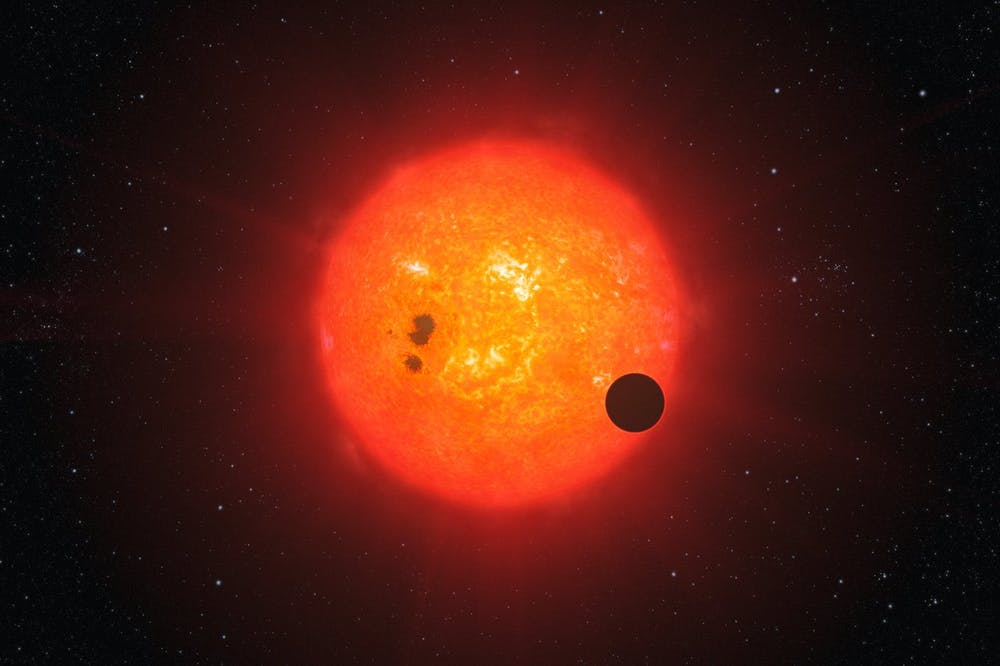Hidden exoplanets may trigger auroras on distant stars
Astronomers may have a new planet-hunting technique at their disposal.

Mysterious radio signals may blast out from auroras on distant stars triggered by hidden planets, a new study finds.
In the new study, researchers used the world's most powerful radio telescope, the Low Frequency Array (LOFAR) in the Netherlands, to analyze radio signals from remote stars. Previously, astronomers could only detect steady radio emissions from the stars nearest Earth — all other faraway radio signals came from interstellar gas, or exotic objects such as black holes.
Now, radio astronomers can detect remote stars, and potentially planets surrounding those stars. "For decades, radio astronomers have been hoping to get in on the exoplanet game, but the sensitivity simply hasn't been there," Benjamin Pope, an astronomer at the University of Queensland in Australia, told Space.com.
Related: The strangest alien planets (images)
LOFAR, with its great sensitivity and huge field of view, "has finally got us there," said Pope, co-author on two new studies detailing the discovery.
In the new research, scientists focused on red dwarf stars, the most common type of star in the universe, making up more than 70% of the stars in our Milky Way galaxy. These stars are small and cold, typically about one-fifth as massive as the sun and up to 50 times dimmer.
Previous research found that red dwarfs can experience intense magnetic activity, which can in turn drive stellar flares and radio emission. However, the scientists discovered radio signals from some old magnetically inactive red dwarfs as well.
Breaking space news, the latest updates on rocket launches, skywatching events and more!
Now the astronomers suggest that these signals come from stellar versions of auroras, known as the northern and southern lights on Earth. "It's a spectacle that has attracted our attention from light-years away," Joseph Callingham, a radio astronomer at Leiden University in the Netherlands and the Dutch national observatory ASTRON and co-author on both new studies detailing the discovery, said in a statement.
When it comes to our planet, these outbursts are produced when energetic particles from the sun collide with Earth's magnetic field. When it comes to Jupiter, its volcanic moon Io blasts material out into space that helps drive unusually powerful auroras.
The researchers suggested that the radio emission from these red dwarfs "is a scaled-up version of Jupiter and Io, with a planet enveloped in the magnetic field of a star, feeding material into vast currents that similarly power bright aurorae," Callingham said in the statement.
"We've discovered signals from 19 distant red dwarf stars, four of which are best explained by the existence of planets orbiting them," Pope said in the same statement. "This discovery is an important step for radio astronomy and could potentially lead to the discovery of planets throughout the galaxy."
The research team now wants to confirm that the proposed planets do exist. "We can't be 100% sure that the four stars we think have planets are indeed planet hosts, but we can say that a planet-star interaction is the best explanation for what we're seeing," Pope said in the statement. "Follow-up observations have ruled out planets more massive than Earth, but there's nothing to say that a smaller planet wouldn't do this."
The scientists now aim to use LOFAR and other telescopes to discover and analyze more of these potential auroras to see if there are repeating patterns in their radio outbursts, which one would expect from a planet regularly completing an orbit around its star that generates a detectable aurora each time it passes between the star and Earth, Pope said.
In the future, radio astronomers may detect more of these potential auroras using the Square Kilometer Array, a giant radio astronomy telescope planned for construction in Australia and South Africa that will hopefully switch on in 2029.
"What we have demonstrated is possible today is just a taste of what the Square Kilometer Array will be able to do," Pope told Space.com. "With sensitivity 10 times LOFAR's and a massive field of view, we expect to discover many hundreds of sources like what we've just found, get much greater precision on nearby ones so that we can understand their detailed physics, and of course, to discover things we have never even predicted."
The scientists detailed their findings online Oct. 11 in the journals Nature Astronomy and Astrophysical Journal Letters.
Originally published on Space.com. Follow us on Twitter @Spacedotcom or Facebook.

Charles Q. Choi is a contributing writer for Space.com and Live Science. He covers all things human origins and astronomy as well as physics, animals and general science topics. Charles has a Master of Arts degree from the University of Missouri-Columbia, School of Journalism and a Bachelor of Arts degree from the University of South Florida. Charles has visited every continent on Earth, drinking rancid yak butter tea in Lhasa, snorkeling with sea lions in the Galapagos and even climbing an iceberg in Antarctica. Visit him at http://www.sciwriter.us
